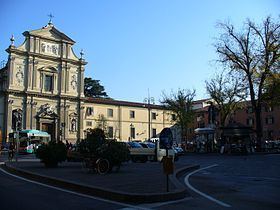Established 1869 Opened 1869 | Website Official website | |
 | ||
Location Piazza San Marco 3, 50121 Florence, Italy Type Art museum, historic site Similar San Marco - Florence, Convent of San Domenic, Medici Chapel, Niccoline Chapel, Ospedale degli Innocenti | ||
Museo Nazionale di San Marco is an art museum housed in the monumental section of the medieval Dominican friary dedicated to St Mark (San Marco), situated on the present-day Piazza San Marco, in Florence, region of Tuscany, Italy.
Contents
The museum, a masterpiece in its own right by the fifteenth-century architect Michelozzo, is a building of very first historical importance for the city, and contains the most extensive collection in the world of the works of Fra Angelico, in the world Guido di Pietro, then later Friar John of Fiesole, who spent several years of his life as a member of the Dominican community here. The works are both paintings on wood and frescoes. The museum also contains other works by artists such as Fra Bartolomeo, Domenico Ghirlandaio, Alesso Baldovinetti, Jacopo Vignali, Bernardino Poccetti and Giovanni Antonio Sogliani.
Until recently San Marco housed a community of Dominican friars, who occupied the Western part of the complex adjacent to the larger cloister. In 2014 the few friars remaining were transferred to join the community at Santa Maria Novella in the city.
From 1934 to 1977 the Catholic politician Giorgio La Pira, who served several terms as Mayor of Florence, lived in the San Marco complex.
San Marco is famous as the seat of Girolamo Savonarola's discourses during his short spiritual rule in Florence in the late 15th century.
San Marco becomes a museum
Like many establishments of its kind throughout Europe, the convent was seized by the civil authorities during the upheavals stemming from the French Revolution and the expansion of the Napoleonic Empire. San Marco met this fate in 1808, returned to Dominican hands after the fall of Napoleon, but then was confiscated in large part by a decree of the nascent Kingdom of Italy dated 7 July 1866 and became State property. This left to the Dominicans the church, the rooms opening on to the Saint Dominic cloister and the area that came much later to house the library containing over 10,000 books specializing in spirituality, founded in 1979 thanks to the bequest of a well known Catholic scholar Arrigo Levasti (1886-1973) and named after him.
In 1869, having been declared a national historical monument, the greater part of the complex reopened as a museum, following repairs and some adjustments to meet the new situation. It was in this period that the frescoes by Fra Angelico were restored by the artist Gaetano Bianchi. In 1906 the museum was chosen to house the remains of architectural value surviving from the buildings demolished by the urban planning measures of the previous century. This led to the creation of a distinct Museo di Firenze antica (Museum of Old Florence). In 1922 the museum managed to add to its collections a large number of works of Fra Angelico, having them transferred from the Uffizi Gallery or the Accademia, an arrangement that has since remained unchanged.
The museum houses the major collection of works by Fra Angelico. Panel paintings included the Deposition executed for Palla Strozzi, the San Marco Altarpiece commissioned by the Medici in 1440, and a Tabernacle of the Linaioli (1433–1435) whose frame was designed by Lorenzo Ghiberti. There are also a great number of small frescoes by Angelico and his assistants in the monastic cells and a number of larger frescoes including the Annunciation. His masterwork is the complex Crucifixion in the Capitular Hall, finished in 1442.
The museum exhibits works by other artists including Domenico Ghirlandaio, a reduced scale version of the Last Supper in the church of Ognissanti; Alesso Baldovinetti, Giovanni Antonio Sogliani and Fra Bartolomeo. The cells where Girolamo Savonarola lived can also be visited.
Also conserved here are surviving architecturally significant remains of buildings that were demolished in the period when Florence was designated as the provisional capital of the largely united Italy in the years 1865-1871), in which it had still not succeeded in annexing its natural historical capital, Rome.
The flood that struck Florence and its art treasures in 1966 did not damage San Marco to the same degree as other sites in the city since the terrain is slightly elevated with respect to the banks of the Arno. Between 1979 and 1983 the former guest quarters were adapted to house works, then recently restored, of Fra Bartolomeo.
In 2007 two small predella panels depicting saints and originally part of the San Marco Altarpiece came to join the museum’s collections, thanks to the initiative of the Office of the Superintendent of Fine Arts and a local bank, the Cassa di Risparmio di Firenze.
